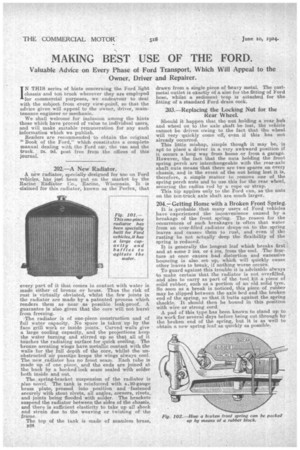MAKING BEST USE OF THE FORD.
Page 14

If you've noticed an error in this article please click here to report it so we can fix it.
Valuable Advice on Every Phase of Ford Transport, Which Will Appeal to the Owner, Driver and Repairer.
IN THIS series of hints concerning the Ford light chassis and ton truck wherever they are employed for commercial purposes, we endeavour to deal with the subject from every view-point so that the advice given will appeal to the owner, driver, maintenance engineer or mechanic.
We shall welcome for inclusion among the hints those which have proved of value to individual users, and will make suitable remuneration for any such information which we publish. Readers are recommended to obtain the original " Book of the Ford," which constitutes a complete manual dealing with the Ford car, the van and the truck. 2s. 9d. post free from the offices of this journal.
202.—A New Radiator.
A new radiator, specially designed for Use on Ford vehicles, has just been put on the market by the Racine Radiator Co., Racine, Wisconsin. It is claimed for this radiator, known as the-Perfex, that every part of it that comes in contact with water is made either of bronze or brass. Thus the risk of rust is virtually obviated, whilst the few joints in the radiator are made by a patented process whichrenders them as near as possible leak-proof. A guarantee is also given that the core will not burst from freezing.
The radiator is of one-piece construction and of full water capacity. No space is taken up by the face grill work or inside joints. Curved walls give a large cooling capacity, and the projections keep the water turning and stirred up so that all of it touches the radiating surface for quick cooling. The bronze aerating wings have metallic contact with the walls for the full depth of the core, Whilst the unobstructed air passage keeps the wings always cool. The new radiator has no front seam. Each tube is made up of one piece, and the ends are joined at the back by a hooked-lock seam sealed with solder both inside and out.
The , spring-bracket suspension of the radiator is Also novel. The tank is reinforced with a,20-gauge brass plate, pressed into position and ' fastened securely with stout rivets, all angles, corners, rivets, and joints being -flooded with solder. The brackets suspend the radiator between the sides of the chassis, and there is sufficient elasticity to take up all shock and strain due to the weaving or twisting of the frame.
The top of the tank is made of seamless brass, drawn from a single piece of heavy metal. The castmetal outlet is exactly of a size for the fitting of Ford hose, whilst a sediment trap is attached for the fitting of a standard Ford dram cock.
203.—Replacing the -Locking Nut for the Rear Wheel.
Should it happen that the nut holding a rear hub and wheel on to the axle shaft be lost, the vehicle cannot be driven owing to the fact that the wheel will very quickly come 'off, even if this has not already occurred.
This little mishap, simple though it may be, is apt to place a driver in a very awkward position if it occurs a long way from home or from a garage. However, the fact that the nuts holding the front spring perch are interchangeable with the rear-axle shaft nuts means that there are two spares on every chassis, and in the event of the nut being lost it is, therefore, a simple matter to remove one of the spring perch nuts and to use this for the rear wheel, securing the radius rod by a rope or strap. This tip applies only to the Ford van, as the nuts on the ton-truck axle shaft are much larger.
204.7 Getting Home with a Broken Front Spring.
It is /probable that many users of Ford vehicles have experienced the inconvenience caused by a breakage of the front spring. The reason for the occurrences of such breakages is often that water from an over-filled radiator drops on to the -spring leaves and causes them to rust, and even if the rusting be not actually deep the flexibility of the spring is reduced.
It is generally the longest leaf which breaks first and at some 3 ins. or 4 ins, from the end. The fracture at once causes bad distortion and excessive bouncing is also set up, which will quickly cause other leaves to break, if nothing worse occurs.
i To guard against this trouble t is advisable always to make certain that the radiator is not overfilled, and also to carry as part of the tool kit a piece of solid rubber, such as a portion of an old solid tyre. So soon as a break is noticed, this piece of rubber may be slipped between the axle bed and the broken end of the spring, so that it butts against the spring shackle. It should then be bound in this position with wire or strong cord.
A pad of this type has been known to stand up to its work for several days before being cut through by the broken end of the spring, but it is as well to obtain a new spring leaf.as quickly as possible:
































